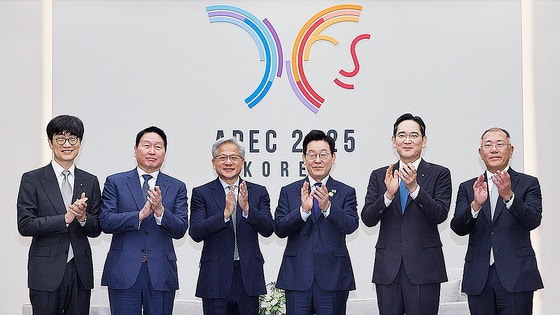
Korea is officially launching a “two-track” AI strategy aimed at building global competitiveness in both text-based foundation models and physical AI models — systems designed to operate in real-world physical environments. This shift follows Korea’s acquisition of 260,000 of Nvidia’s latest graphics processing units (GPUs).
“At a time when there is fierce global competition for GPUs, securing 260,000 units carries major significance in terms of supply stability,” a senior official from the Ministry of Science and ICT told the JoongAng Ilbo on Sunday. “The country’s AI strategy will expand from the development of proprietary foundation models to physical AI models.” The plan aims not only to close the gap with global tech giants in large language models (LLMs) but also to leverage Korea’s strengths as a manufacturing powerhouse to build its own physical AI models.
"Korea now possesses the third-largest AI infrastructure in the world after the United States and China, based on GPU volume," Ha Jung-woo, senior secretary for AI future planning in the presidential office, said during a briefing on Friday. Nvidia added that with its new Blackwell infrastructure, Korea’s total GPU count will rise from 65,000 to over 300,000. Of the newly secured GPUs, up to 50,000 will go to the government, with Samsung Electronics, Hyundai Motor Group and SK Group each receiving 50,000 units, and Naver Cloud receiving 60,000.
The most significant outcome of this GPU acquisition is that Korea can now build an independent ecosystem for physical AI. With one of the world’s most advanced manufacturing sectors, Korea is well-positioned to develop industry-specific AI models. If successful, these models could drive the AI transformation of core national industries while positioning Korea as a global leader in next-generation AI. Unlike the LLM space, where astronomical capital requirements have kept Korea on the back foot, physical AI presents an opportunity to take the lead.
Across the industry, there is a growing consensus that physical AI will define the next era of AI. Yann LeCun, Meta’s chief AI scientist and professor at New York University, recently pointed out that LLMs have reached their fundamental limits during a symposium on Oct. 27. He argued that next-generation AI must go beyond predicting the next word and instead understand and reason through physical environments, much like humans do.
Nvidia has already moved into building a physical AI ecosystem based on real-world data. CEO Jensen Huang said at CES 2025 in January, “The ChatGPT moment for general robotics is just around the corner,” noting that we are entering the era of physical AI, capable of processing, reasoning, planning and acting. His son, Spencer Huang, a project lead in Nvidia’s robotics division, also told the JoongAng Ilbo in a recent interview that physical AI is ushering in an era in which machines can touch, sense and learn about the world on their own.
Given Korea’s strengths in semiconductors, shipbuilding and automotive manufacturing, the country is an appealing partner for Nvidia’s ambitions. But to lead the global physical AI ecosystem, Korea must deliver tangible success stories.
"Unlike LLMs, physical AI does not yet have standardized methods for data collection," said the CEO of a domestic physical AI company. "Since the competition is technical rather than financial, Korea can gain ground quickly if it moves decisively.”
Accumulating success stories could also support global expansion. A representative from Naver Cloud said, “We will support the AI transformation of domestic manufacturers through physical AI platforms and cloud infrastructure,” adding, “If we succeed locally, we can ultimately expand abroad.”
The key will be establishing an ecosystem that enables manufacturers to adopt physical AI quickly.
“Now that we have secured GPUs in large volumes, we can develop and deploy our own physical AI without relying on Big Tech," said Yu Bum-jae, principal researcher at the Korea Institute of Science and Technology’s Intelligent Robotics Research Division. "The infrastructure must now be built to ensure that physical AI spreads rapidly on the manufacturing floor.”
This article was originally written in Korean and translated by a bilingual reporter with the help of generative AI tools. It was then edited by a native English-speaking editor. All AI-assisted translations are reviewed and refined by our newsroom.
댓글목록
등록된 댓글이 없습니다.